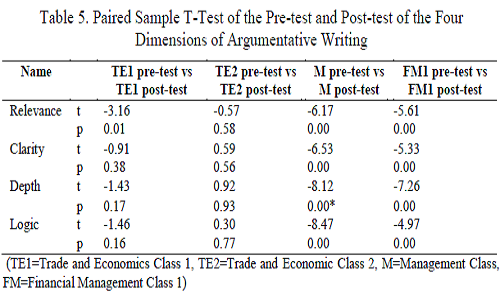
The Effects of an Integrated Writing Task on Undergraduates’ Critical Thinking in English Argumentative Writing
Abstract
Keywords
Full Text:
PDFReferences
Chason, L., Loyet, D., Sorenson, L., & Stoops, A. (2016). An approach for embedding critical thinking in second language paragraph writing. TESOL Journal, 8(3): 582-612.
Chen, Y. (2019). Developing students’ critical thinking and discourse level writing skill through teachers’ questions: A sociocultural approach. Chinese Journal of Applied Linguistics, 42 (2): 141-162.
Dong, Y. N. (2017). Teaching and assessing critical thinking in second language writing: An infusion approach. Chinese Journal of Applied Linguistics, 40(4): 431-451.
Ebadi, S. & Rahimi, M. (2018). An exploration into the impact of WebQuest-based classroom on EFL learners’ critical thinking and academic writing skills: A mixed-methods study. Computer Assisted Language Learning, 31(5-6): 617-651.
Gao, X., & Wen, Q. F. (2017). Effects of critical thinking skills via linguistic factors on L2 writing performance. Foreign Language Learning Theory and Practice, (4): 44-50.
Jin, X. H. (2018). The teaching approach of cultivating the critical thinking ability in college English argumentative composition. Journal of Jiangxi Normal University, 51(2): 134-139.
Kumar, R., & Refaei, B. (2017). Problem-based learning pedagogy fosters students’ critical thinking about writing. Interdisciplinary Journal of Problem-Based Learning, 11(2), 1-10.
Li, L. W. (2011). An action research on how to increase reader awareness and critical thinking. Foreign Languages in China, 8 (3): 66-73.
Paul, R., & Elder, L. (2006). Critical thinking: Learn the tools the best thinker use. New Jersey: Pearson Prentice Hall.
Peng, M. C., Wang, G. C., Chen, L. J., Chen, M. H., Bai, H. H., Li, S. G., Li, J. P., Cai, Y. F., Wang, J. Q., & Yin, L. (2004). Validity and reliability of the Chinese critical thinking disposition inventory. Chinese Journal of Nursing, 39(9): 644-647.
Stephenson, N. S., Miller, I. R., & Sadler-McKnight, N. P. (2019). Impact of peer-led team learning and the science writing and workshop template on the critical thinking skills of first-year chemistry students. Journal of Chemical Education, 96: 841-849.
Stapleton, P., & Wu, Y. M. (2015). Assessing the quality of arguments in students’ persuasive writing: A case study analyzing the relationship between surface structure and substance. Journal of English for Academic Purposes, 17: 12-23.
Tsui, L. (1999). Courses and instruction affecting critical thinking. Research in Higher Education, 40(2): 185-200.
Wang, B. J. (2019). An empirical research on the influence of the integration of oral activities and critical thinking teaching on argumentative writing—based on PEM and POA. Foreign Language Education, 40(5): 51-56.
Wen, Q. F. (2012). Current condition of the critical thinking skills of foreign language-majored students in China. Beijng: Foreign Language Teaching and Research Press.
Wen, Q. F., & Liu, R. Q. (2006). An exploratory study on features in English majors’ abstract thinking in English argumentative compositions. Journal of Foreign Languages, (2): 49-58.
Yu, J. Y. (2014). The construction of a writing-critical thinking integration teaching method. Foreign Language World, (5): 20-28.
Zeng, M. R. (2012). Argumentative writing and the cultivation of critical thinking ability. Education Teaching Forum, 23, 67-70.
Zhang, X. (2018). Developing college EFL writers’ critical thinking skills through online resources: A case study. SAGE Open, 8(4): 1-12.
DOI: http://dx.doi.org/10.31258/jes.6.2.p.200-209
Refbacks
- There are currently no refbacks.
Copyright (c) 2022 Huiying Diao, Zhencong Liu

This work is licensed under a Creative Commons Attribution 4.0 International License.
Publisher: FKIP Universitas Riau












